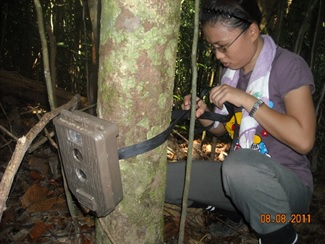The Sunda pangolin (Manis javanica) is rare, elusive and endangered, and is the only species of pangolin found on the island of Borneo. It has been sighted and recorded in remote primary and secondary forest and plantations as well as near human settlements. Pangolins, also known as scaly anteaters, get their names from the Malay word ‘Pengguling’ meaning ‘rolling ball’ which refers to their habit of rolling into a ball when resting or when threatened. They are important animals in the ecosystem in which they occur because they act as natural pest controllers and help to regulate ant and termite populations. Some estimates suggest they consume about 70 million insects per year and their digging action during feeding also helps aerate the soil.
In Southeast Asia, pangolins are severely threatened by widespread hunting and illegal international trade as well as by deforestation for development and logging purposes. Today, they are one of the most valuable wild animals in Sabah and with an increased demand for the species and declining populations, prices for them have risen. Of all the Asian pangolins, the Sunda species is the most heavily traded, and large-scale cases of pangolin trafficking have been recorded by police and other agencies in Sabah. Confounding their conservation predicament is the fact that they don’t do well in captivity and there is no record of successfully maintaining pangolins in captivity in Sabah either. Future conservation efforts should focus on protecting the habitat, and learning more about their ecology and biology, and ending illegal hunting and trade.
Pangolins are also understudied meaning little is known about their ecology, population levels, and life history. My research focuses on the ecology of the Sunda pangolin in Sabah, East Malaysia and commenced in 2011. The aims of the study are to investigate the activity and habitat use of the Sunda pangolin and to determine its conservation status. My approach utilizes non-invasive methods including field surveys, camera traps and interviews with local villagers. Field surveys are divided into day and night tracking. During the day, I search for indirect signs of pangolin such as dens or burrows, scratches and foraging sites. During the night, I search
for direct signs like the sound of the animals moving around, their smell and visual sightings, either on the ground or up in the trees. I have also set up camera traps along transects to detect pangolin presence and collect data on when they are active and in which microhabitats they occur. I’ve also conducted a series of interviews with local villagers to learn from them about pangolin ecology and hunting activities in Sabah and they have also helped me with conducting fieldwork. Finally, I’ve also been able to successfully radio-track pangolins to find dens and burrows to document their characteristics. Although there is more to be done my research has contributed to an increased knowledge of the ecology of the Sunda pangolin, its ecological niche and conservation status. It has also helped to promote public awareness of pangolins and identify conservation actions for the species.
by Elisa Panjang, Institute for Tropical Biology and Conservation, Universiti Malaysia Sabah and member of the IUCN SSC Pangolin Specialist Group.





